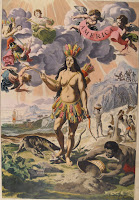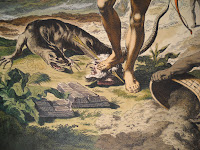In 1662, Joan Blaeu published his 11-volume Grand Atlas, Geographia. The frontispiece to the final volume depicted the New World in allegorical terms. America stands amid a scene of wealth and violence, her foot placed on the severed head of a European, an arrow shot clean through his skull.
What is that all about? We have used it for years in classes where we discuss the various components of the image--the Conquistador ushering in Christianity, the bars of silver, the exotic caiman-like lizard--but it was not until this spring that we acquired the key, the 1618 edition of Cesare Ripa's Nova Iconologia (Padua: Pietro Paolo Tozzi, 1618).
The Nova Iconologia was first published without illustrations in 1593, then with 151 images in 1603. This 1618 edition contains over 300 woodcuts with descriptions that were used by artists and poets to make abstract concepts like the passions, virtues and vices, and even places, concrete in form. The book influenced late-Renaissance artists and is an essential guide to the imagery of the time. America appears on page 353, looking very much like Blaeu's later frontispiece. The detailed explanation of the iconography reveals that the severed head is all that remains of a victim of the barbaric cannibals.
To see the Blaeu atlas, ask for Rare Book G1015.B48 1662. For the Ripa, request Rare N774.R52 1618.



No comments:
Post a Comment